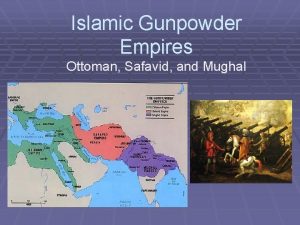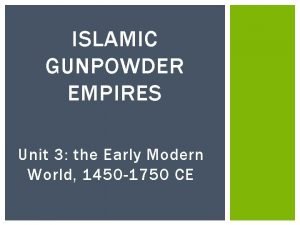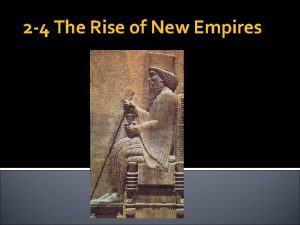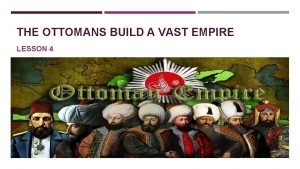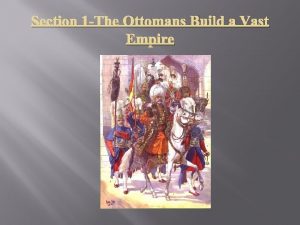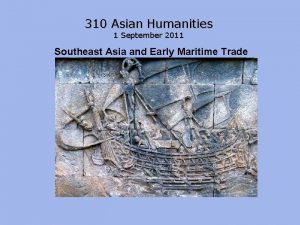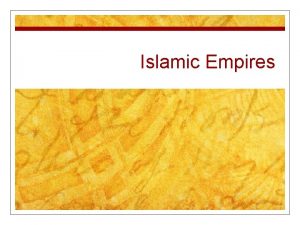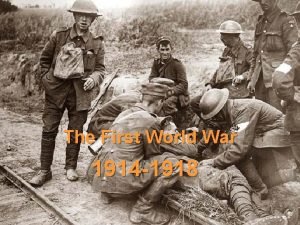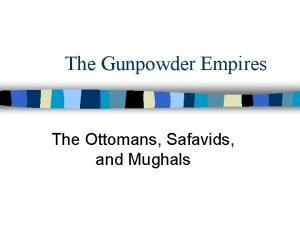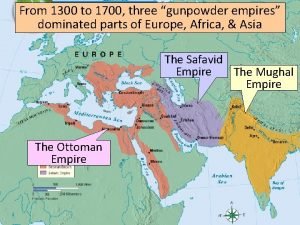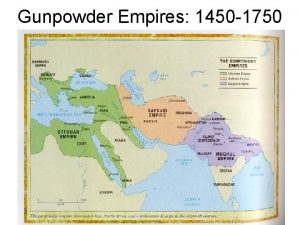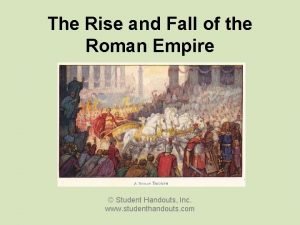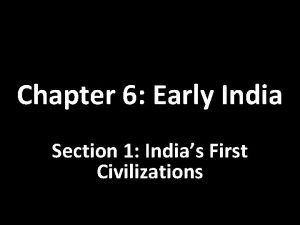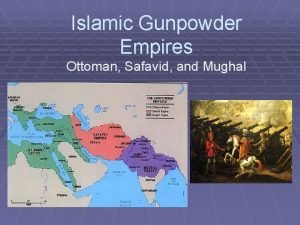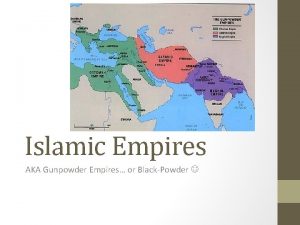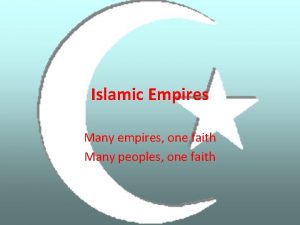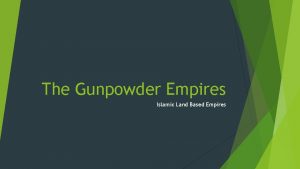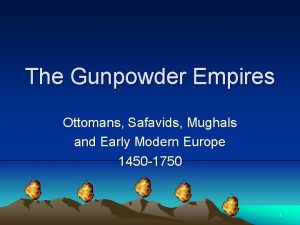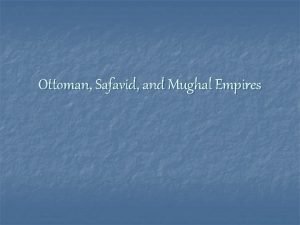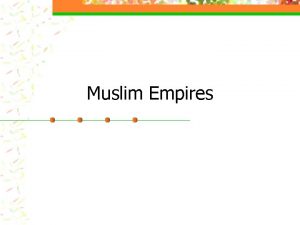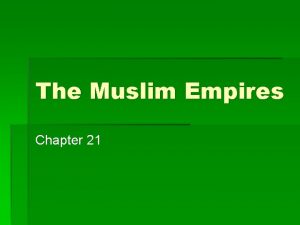ISLAMIC EMPIRES THE OTTOMANS THE RISE OF THE



































- Slides: 35

ISLAMIC EMPIRES

THE OTTOMANS

THE RISE OF THE OTTOMANS (OOMMSS) • By 1300, the Byzantine Empire was declining, and the Mongols had destroyed the Seljuk Turks. • A small Turkish state occupied land between the Byzantine Empire and that of the Muslims. • From this place, a strong leader would emerge to unite the Turks into a great empire.

GHAZIS CODE • Many Turks saw themselves as ghazis, or warriors for Islam. • They formed military societies under the leadership of an emir, a chief commander, and followed a strict Islamic code of conduct.

OSMAN 1300 - 1326 • The most successful ghazi was Osman and Westerners named his followers Ottomans. • Osman built a small Muslim state in Anatolia between 1300 and 1326. His successors expanded it by buying land, forming alliances with emirs, and conquering. • The Ottomans’ military success was based replacing archers on horseback with musket troops

TIMOR HALTS OTTOMAN EXPANSION • During their early expansion, the Ottomans faced defeat at the hands of Timor, a ruthless central Asian ruler. • When Timor turned Eastward, the Ottomans recovered and continued to expand, mainly at the expense of the Byzantine empire.

OTTOMANS EXPAND • In 1453, Sultan Mehmed the Conqueror achieved the most dramatic feat in Ottoman history by capturing Constantinople. • In 1514, Mehmed’s grandson, Selim the Grim, defeated the Safavids of Persia • Soon, Selim captured Syria, Palestine, Egypt, and Mecca and Medina.

SULEYMAN THE CONQUEROR • Suleyman, a superb military leader, came to the throne in 1520 and ruled for 46 years. • He conquered the Eastern European city of Belgrade in 1521. • The next year, Turkish Naval forces dominated the whole eastern Mediterranean. • In 1526, Suleyman’s armies then pushed to the outskirts of Vienna, Austria. • Reigning from Istanbul, Suleyman had become the most powerful monarch on earth.

SULEYMAN THE LAWGIVER • Suleyman’s Reforms • Law Codes. Suleyman created a secular and uniform law code for criminal and civil actions. • Protection of Minorities. Christians were given certain land holding rights and Jews were offered protections against persecutions. • Downsizing. He reduced bureaucracy and revised the system of taxation.

SULEYMAN THE KIDNAPPER • Under the devshirme system, the sultan’s army drafted boys from the peoples of conquered Christian territories. The army educated them, converted them to Islam, and trained them as disciplined and loyal soldiers called JANISARRIES.

SULEYMAN THE MAGNIFICENT • In accordance with Islamic law, the Ottomans granted freedom of worship to other religious communities, such as Christians and Jews • Suleyman led to great cultural achievements of the empire. He funded poetry, history, geography, astronomy, mathematics, and architecture leading to a Turkish Renaissance known as the Golden Age.

IMPROVED CONDITIONS FOR WOMEN • Ottoman interpretation of Sharia law was more tolerant in defining the legal position of women. • This tolerant attitude was probably due to the traditions among the Turkish people, who regarded women as almost equal to men. • Women were allowed to own and inherit property. They could not be forced into marriage and, in certain cases, were permitted to seek divorce. • As a result, women served as senior officials, such as governors of provinces.

THE EMPIRE’S DECLINE • Despite Suleyman’s great achievements, the Ottoman Empire was losing ground, because: • Fratricide and filicide • Harem life and over indulgence • Extreme measures to keep western influences out (no coffee, smokes) • a coalition of European Catholic maritime states arranged by Pope and led by Don Juan defeated the Ottomans.

THE SAFAVID

PERSIA UNDER ISLAM • For years, Persia had been under the control of the Abbasid caliphate. • When the Mongols killed the last caliph, Persia fell into the hands of Mongols and then Timor. • But as the empire of Timor’s successors weakened, a Shiite brotherhood local to Persia rose and seized control.

ORIGINS OF THE SAFAVIDS • Originally, the Safavids were members of an Islamic religious brotherhood named after their founder, Safi al-Din. • In the 15 th century, the Safavids aligned themselves with the Shi’a branch of Islam. • To protect themselves from these potential enemies, the Safavids concentrated on building a powerful army.

PERSIA UNDER ISMAIL • In 1499, a 12 -year-old named Ismail began to seize most of what is now Iran. • To celebrate his achievement, he took the ancient Persian title of shah, or king. • Shi’ites supported him believing him to be a descendent of Muhammed • Ismail became a religious tyrant. Any citizen who did not convert to Shi’ism was put to death.

SAFAVID ENEMIES • Religious conflict pitted Ottoman against the Safavid forces in 1514. Using artillery, the Ottomans pounded the Safavids into defeat. One result of the battle was to set the border, which remains the border separating Iran and Iraq. • Persians under the Safavid expanded with varying success against Mughals of India.

ABBAS THE GREAT • Shah Abbas, or Abbas the Great, took the throne in 1587. His Reforms included • Military Reforms. recruited from the Christian north and modeled after the Ottoman janissaries. He equipped both of these armies with modern artillery. • Government Reforms. He punished corruption severely and promoted only officials who proved their competence and loyalty. • Economic/religious Reforms. To encourage trade, he allowed religious freedom.

GOLDEN AGE UNDER ABBAS • He created a Safavid culture that drew from Ottoman, Persian, and Arab. • The Shah built a new capital at Esfahan, which was considered one of the most beautiful. • Shah Abbas brought hundreds of Chinese artisans to Esfahan. Working with Safavid artists, they produced intricate metalwork, miniature paintings, calligraphy, glasswork, tile work, and pottery. JAMA MOSQUE ISTFAHAN SHAH MOSQUE ISTFAHAN


PERSECUTION AND INTOLERANCE • Under Ismail, early persecution of Non Shi’ites. • Under Ismail, slaughter of Sunni in Baghdad. • Under Abbas, Jews were forced to convert to Islam or leave. • Women • Were subordinate to men • Lost legal and hereditary rights • subject to strict laws and codes: • Veiling when out in public

STRUGGLE FOR WOMEN’S RIGHTS • There was a struggle against these restrictions • Some women openly refused to wear face covers while in public • ◦Women donned bright clothing in defiance • ◦Women were active in trade & moneylending • ◦Women protected their rights and even divorced if conditions in marriage had become intolerable.

THE EMPIRE’S DECLINE • In finding a successor, Shah Abbas made the same mistake the Ottomans had made. He killed his ablest sons, while pampered young princes led the Safavids down the same road to decline. • Afghan peoples moved in and took the capital. • There was chaos and lawlessness for years as Iran became the target of stronger empires.

THE MUGHALS

PRE MUGHAL HISTORY • Local leaders from different empires ruled India for years. • Starting at 1000 AD, Turkish armies swept in. They devastated Indian cities and temples. • Delhi became the capital of a loose empire of Turkish warlords. • By the 1500’s, the power of the Delhi Sultans weakened as Indian warrior princes known as Rajputs fought back.

BABUR THE CONQUEROR • In 1494, an boy named Babur inherited a kingdom Northwest of India. • Babur built up an army. In the years that followed, he swept down into India and laid the foundation for the vast Mughal Empire. • In 1526 he took New Delhi in a brilliant military move.

AKBAR THE CONQUEROR • Babur’s grandson was called Akbar, which means “Greatest One. ” • Akbar ruled India with wisdom and tolerance from 1556 to 1605. • Like the Safavids and the Ottomans, Akbar equipped his armies with heavy artillery. • He appointed some rajputs as officers of areas he conquered.

AKBAR THE WISE • Religious Freedom. He abolished the tax on Hindu pilgrims and on non-Muslims. • Taxes. He levied a tax similar to the U. S. graduated income tax, calculating it as a percentage of the value of the peasants’ crops. • Meritocracy. Akbar governed through a bureaucracy of officials. Natives and foreigners, Hindus and Muslims, could all rise to high office.

AKBAR AND WOMEN RIGHTS • Women treatment before Akbar • Sati (Hindu) • Child brides (Hindu, Muslim) • Seclusion and veiling (Muslim) • Limited rights (inheritance) as wife (Muslim) • Under Akbar • No child brides • Outlawed Sati • After Akbar • Women status declined as before • Both Hindu and Islamic influences kept women status historically low.

AKBAR AND THE GOLDEN AGE • He welcomed influences from the many cultures in art, education, politics, and language. Akbars Mausoleum • Persian was the language of Akbar’s court The common people, however, spoke Hindi, a mixture of Persian and a local language. • Literature and art enjoyed a rival. • Akbar devoted himself to architecture, by building massive but graceful structures with intricate stonework that portrays Hindu themes • The capital city of Fatehpur Sikri is an example of this type Entrance

JAHANGIR AND RELIGIOUS DIVISION. • In 1605, Akbar’s son Jahangir took over, leaving state affairs to his wife, a Persian princess. • The crown prince, fearing her influence, rebelled and turned to a mystic Islamic and Hindu movement known as the Sikhs • Jahangir reacted by blinding the prince and unleashing his anger on Sikhs and non Muslims.

SHAH JAHAN OBSESSION AND SUFFERING • Fratricide. Jahangir’s son and successor, Shah Jahan, could not tolerate competition and secured his throne by assassinating all his possible rivals. • He had a great passion for two things: beautiful buildings and his wife Mumtaz Mahal. To enshrine his wife’s memory, he built The Taj Mahal • But while Shah Jahan was building lovely things, his country was suffering and there was civil war. When Shah Jahan became ill in 1657, his four sons scrambled for the throne.

AURANGZEB INTOLERANCE AND INSURRECTION • Aurangzeb seized control, killing his brothers and imprisoning his father. • A master at military strategy, he ruled from 1658 to 1707, expanding the Mughal holdings to their greatest size after conquering Rajputs to the South, known as Marathas. • However, the power of the empire weakened. • By the end of his reign, he had drained the empire of its resources. Many died of starvation. Guru executed at Mehdiana Sahib

DECLINE, EUROPEAN TRADE, AND FALL • After Aurangzeb’s death, his sons fought a war. • Afterwards, the Mughal emperor was nothing but a wealthy figurehead who ruled a patchwork of independent states. • As the Mughal Empire rose and fell, Western traders slowly built their own power in the region. • In 1661, Aurangzeb handed the English the port of Bombay, which they used to later conquer the entire country. Queen Victoria became Queen of England the British ruled until 1947.
 Impaler state of decay 2
Impaler state of decay 2 Maritime based empires a comparison chart
Maritime based empires a comparison chart Chapter 27 the islamic empires
Chapter 27 the islamic empires Chapter 19 islamic gunpowder empires
Chapter 19 islamic gunpowder empires Islamic gunpowder empires
Islamic gunpowder empires Islamic gunpowder empires webquest
Islamic gunpowder empires webquest Chapter 27 the islamic empires
Chapter 27 the islamic empires Guided reading activity 2-4 the rise of new empires
Guided reading activity 2-4 the rise of new empires Ottoman empire founder
Ottoman empire founder The ottomans build a vast empire
The ottomans build a vast empire Where did the ottomans come from
Where did the ottomans come from Where did the ottomans come from
Where did the ottomans come from Rise and rise until lambs become lions
Rise and rise until lambs become lions A union b example
A union b example Tricky dicky richard nixon
Tricky dicky richard nixon Little lambs academy
Little lambs academy Empires in southeast asia
Empires in southeast asia Gunpowder empires map
Gunpowder empires map Colonial empires 1914
Colonial empires 1914 Map of gunpowder empires
Map of gunpowder empires Empires
Empires Political transformations empires and encounters
Political transformations empires and encounters Colonial empires in latin america
Colonial empires in latin america 3 gunpowder empires
3 gunpowder empires Early empires in the ancient near east
Early empires in the ancient near east The maurya and gupta empires
The maurya and gupta empires Land based empires 1450 to 1750
Land based empires 1450 to 1750 Empires
Empires Gunpowder empires characteristics
Gunpowder empires characteristics Carte empire coloniaux 1740
Carte empire coloniaux 1740 Chapter 17 nomadic empires and eurasian integration
Chapter 17 nomadic empires and eurasian integration Chapter 7 section 1 india's first empires
Chapter 7 section 1 india's first empires Maritime empires link regions
Maritime empires link regions Building overseas empires
Building overseas empires Inca aztec maya civilization map
Inca aztec maya civilization map Empires
Empires
